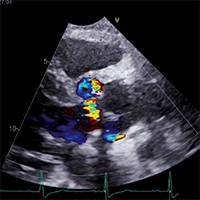 Smart Citations
Smart CitationsSee how this article has been cited at scite.ai
scite shows how a scientific paper has been cited by providing the context of the citation, a classification describing whether it supports, mentions, or contrasts the cited claim, and a label indicating in which section the citation was made.
Echocardiographic evaluation of paravalvular aortic regurgitation of a patient with recurrent aortic valve replacements
Paravalvular regurgitation (PVR) is a serious complication after surgical valve replacement. Echocardiography is the gold standard technique to assess the severity of PVR with an integrated approach. A 48-year-old male underwent aortic valve replacement due to infective endocarditis (IE). During in-hospital cardiac rehabilitation after a redo surgery for a new IE three years later, an echo-free anterior space around the valve with several PVRs through transthoracic echocardiography (TTE) was identified. On transesophageal echocardiography (TOE) a double PVR (anterior and posterior) with abscessual cavity was detected. The patient’s conditions worsened within six months with hemodynamic instability: a massive PVR due to a large abscess cavity next to the right cusp was confirmed by TTE and TOE and a third surgery was carried out. On the third admission at our Rehabilitation Unit the echo features were normal. Patient did not report any cardiovascular symptoms at 1 year follow-up.
How to Cite

This work is licensed under a Creative Commons Attribution-NonCommercial 4.0 International License.
PAGEPress has chosen to apply the Creative Commons Attribution NonCommercial 4.0 International License (CC BY-NC 4.0) to all manuscripts to be published.

 https://doi.org/10.4081/monaldi.2021.1765
https://doi.org/10.4081/monaldi.2021.1765





